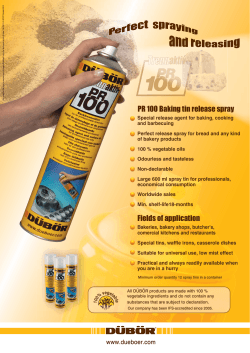
TIDES 2015 â Intranasal Drug Delivery
Intranasal Drug Delivery: Drug Development Considerations Bruce H Morimoto, PhD Executive Director, Applied Translational Medicine May 6, 2015 Why the Nose? Rapid, fast onset Nasal epithelium highly vascularized Large absorption area Non-invasive Painless, no needles or injections Easy administration by patient or caregiver Amenable to peptides, oligos and biologics Avoid gastric degradation No hepatic first-pass metabolism 2 The Nasal Cavity Olfactory epithelium Roof of the nasal cavity, represents ~10% of total surface area Direct access to olfactory bulb Respiratory region Epithelial tissue highly vascularized Site of drug absorption to systemic circulation 3 Nasal Drug Delivery 4 From McGraw-Hill Nasal Spray Distribution Optinose: Breath-powered delivery Impel: Pressurized Olfactory Delivery 5 Drug Development Considerations Product Characterization Objectives Reproducibility of content Consistency of delivery Potential impact on both Safety Efficacy Nasal drug products 7 Formulation Spray device Physical and Chemical Tests Test Parameter Description Description Appearance, size, color should be tested and within acceptance criteria. Identification Two independent chromatographic procedures used to verify the identity of the drug substance in the drug product. Assay Analytical determination of drug substance and stability determination. Impurities and Degradation Products Preservatives and Stabilizing Excipients Assay Levels of impurities and degradation products to be determined by a validated analytical procedure. Impurities > 0.1% must be reported and specified. If present, preservative, antioxidants, chelating agents, or other stabilizers should be assayed. Microbial Limits Microbial quality should be controlled and show that the product does not support the growth of microorganisms throughout expiration. Tests should include total aerobic, yeast and mold count, and absence of designated organisms. Net Content Net content of the formulation in each container should be within release specifications. pH pH should be within acceptance criteria. Osmolality Osmolality should be tested for products that contain an agent to control tonicity. Viscosity Viscosity should be tested for products that contain an agent contributing to the viscosity, both upon release and during stability. 8 Adapted from: FDA: Guidance for industry: nasal spray and inhalation solution, suspension, and spray drug products Nasal Formulations Absorption enhancers Surfactants, cyclodextrins, bile salts, tight-junction modifiers Osmolarity Iso-osmolarity: ~280 mOsm/kg Hypo-osmotic (<50 mOsm/kg): can improve absorption, but also increase potential for epithelial damage Hyper-osmotic (>900 mOsm/kg): increase in mucus secretions pH Nasal cavity is slightly acidic, pH 5.5-6.5 pH <3 or >10 has been shown to result in histo damage Irritation can occur outside physiological range Viscosity 9 Can increase residence time in nasal cavity, but also affect spray characteristics (droplet size) Nasal Spray Device Tests Test Parameter Description Pump Delivery Pump delivery testing should be performed to assess delivery and reproducibility. Typically, the weight of individual sprays should be within 15% or the target weight, and their mean within 10% of the target weight. Spray Content Uniformity Individual sprays should be analyzed for drug substance content in multiple sprays, at the beginning and at the end of an individual container, among containers and among different batches. Spray Pattern and Plume Geometry Spray pattern testing should be performed on a regular basis, and acceptance criteria should include shape and size of the pattern. Plume geometry is typically established during the characterization of the product and does not need to be tested routinely after. Droplet Size Distribution Droplet size distribution should be controlled in terms of ranges for the D10, D50, D90, span and percentage of droplets <10µm. Particle Size Distribution Required for suspension nasal sprays only, and should include acceptance criteria for particle size distribution of the drug substance particles in the formulation. Particulate Matter Levels of particulate matter should be tested with appropriate acceptance criteria. Weight Loss (Stability) Weight loss should be assessed for samples stored on stability, in two different container orientations. Leachables (Stability) Analytical methods to identify, monitor and quantify leached components should be established. 10 Adapted from: FDA: Guidance for industry: nasal spray and inhalation solution, suspension, and spray drug products Additional Drug Product Characterization Pump priming and sprays per unit How many actuations needed until the spray unit delivers the desired dose/volume? How many usable sprays per unit? Re-priming and in-use How long can a spray unit sit before it needs to be primed again? Will delivery be sufficient when used as per the clinical protocol? Preservative effectiveness 11 Will the preservative prevent microbial contamination with use? Priming and Usable Spray 120 Aptar VP7 pump 3 mL fill placebo 1 placebo 2 Percent Delivered 100 placebo 3 80 Usable sprays 60 40 20 0 1 3 5 7 9 11 13 15 17 19 21 Spray Number Priming 12 23 25 27 29 31 In-use Study How long can the spray unit sit before it needs to be reprimed? Spray unit primed then left upright on the benchtop for 4 days Unit then actuated and spray weight measured Conclusion: spray units do not need to be reprimed if unused for up to 4 days Day 1-AM Day 4-PM 0.1200 0.1200 0.1000 0.0800 gm delivered gm delivered 0.1000 0.0600 0.0400 0.0600 0.0400 0.0200 0.0200 0.0000 0 2 4 6 Spray # 13 0.0800 8 10 12 0.0000 0 2 4 6 Spray # 8 10 12 Nonclinical Studies Local tolerance – often a function of the formulation (enhancers, preservative) Cultured nasal epithelia Assessment of irritation in tox studies Clinical observations (dryness, secretions, redness) Histopathological evaluation Changes in olfactory function 14 Zinc gluconate, case example Histopathology in tox studies Smell identification tests in clinical studies Nonclinical Studies Defining the maximum tolerated dose (MTD) Regulatory agencies want to understand dose and target organ toxicity Multiples of the intended clinical dose not usually sufficient Maximum feasible dose (MFD) 15 Justify the high dose tested MFD defined by solubility and volume of administration Volume of administration dependent on species Trade-off: Increasing volume also increases variability Multiple dosing sessions, alternating nares Comparative Anatomy http://www.aafp.org/afp/2000/0115/p427.html 16 Species Comparison Body Weight (kg) Nasal Volume (mL) Nasal Surface Area (cm2) Man 70 20 160 Monkey 7 8 62 Dog 10 20 221 Rat 0.25 0.4 14 Mouse 0.03 0.03 2.8 17 Adapted from: Gizurarson S: Animal models for intranasal drug delivery studies. A review article. Acta Pharm Nord 2(2), 105-122 (1990) Nonclinical Intranasal Dose Administration Points to consider Rodents Pipettor Dispense small bead Place near nostril Allow normal inspiration for uptake into nasal cavity Dogs Incredibly important to train animals to accept dosing Exclude animals that do not take to dosing 18 Bridge from Nonclinical to First-in-Human No Observed Adverse Effect Level (NOAEL) from animal safety studies used to inform a starting clinical dose Allometric scaling is one method to compare doses between species 19 For example, body surface area (rather than body weight) is used to scale systemic drugs Scaling for nasal administered drugs is more challenging because of the large differences in intranasal anatomy. From previous table, the nasal surface area-to-body weight is: Human: 2.3 Dog: 22 Rat: 56 If systemic exposure is the objective for nasal delivery, then allometric scaling by dose-exposure can be justified Case-Study: Intranasal davunetide Nose-to-brain? If intranasal administration bypasses systemic circulation… How to assess exposure for safety considerations? Will anatomical differences between species effect transport to the brain? What is the impact on translation from animal to human? For davunetide clinical development program, demonstrated: nose systemic circulation brain Rat pharmacokinetic study: continuous CSF collection CSF exposure proportional to systemic exposure and Independent of route of administration Quantitative whole-body autoradiography: kinetic study Intranasal and intravenous administration Showed brain exposure no greater after intranasal administration (compared to IV) for an equivalent dose No increase in olfactory bulb exposure after intranasal administration 21 Human Pharmacokinetics (PK) Open-label, single dose, plasma and continuous CSF collection Lumbar (L3-L4) catheterization CSF collected at 0.2 mL/min for 4 hours, 1 mL fractions 6 subjects per group Measured drug levels as well as various AD biomarkers Healthy Adult (18-45 years) 50 mg intravenous 300 mg intravenous 15 mg intranasal 22 Plasma & CSF Profile: 50 mg IV Continuously collect CSF and plasma Healthy subjects (n=6) Measure drug levels with validated LC-MS/MS assay 23 Compartmental PK Modeling Explored various compartmental PK models Best fit: Two-compartment model Computational model predicts experimental data Input (intranasal) 0 Ka 1 /F 2 1 /F 1 3 CL/F Peripheral Volume of Distribution (for IV and IN) dA 2 Q × A1 Q × A 2 = − dt Vc Vp CSF: dA 3 = + ( Kin10 to LAG1 +Kin2LAG1 to LAG2 ) ×A1 - [ Kout LAG2 to ∞ × A 3 ] dt 24 Intranasal PK Input Nose-tobrain (intranasal) 0 Ka 1 /F 1 /F 1 2 3 CL/F The IV compartmental model fits the intranasal plasma and CSF data Suggests pharmacokinetics in CSF is a function of plasma concentrations Intranasal drug administration results in systemic distribution (not direct nose-tobrain) Compartmental PK model allowed for: PK simulation to evaluate dose and dose paradigms for optimization of steady state CSF concentrations PK model allowed for sparse blood sampling in Phase II/III 25 Summary Advantages Non-invasive Rapid absorption Amenable to peptides and biologics Disadvantages 26 More complex drug product characterization and stability Challenges with local irritation, potential for unblinding? Nonclinical dose selection and scaling Potentially low bioavailability References Campbell C., Morimoto BH., Nenciu D., Fox AW. (2012) Drug development of intranasally delivered peptides. Therapeutic Delivery 3(4), 557-568 Dhuria SV, Hanson LR, Frey WH, 2nd (2010) Intranasal delivery to the central nervous system: mechanisms and experimental considerations. J Pharm Sci 99(4), 1654-1673 Merkus FW, Van Den Berg MP (2007) Can nasal drug delivery bypass the blood-brain barrier?: questioning the direct transport theory. Drugs R D 8(3), 133-144 Maggio, ET (2006) Intravail: highly effective intranasal delivery of peptide and protein drugs. Expert Opin. Drug Deliv. 3(4), 529-539 27 Questions? bruce.morimoto@celerion.com 28
© Copyright 2025










